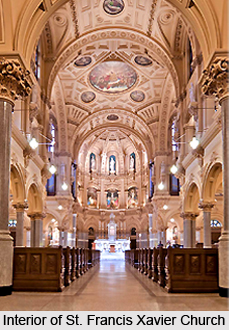 Francis Xavier, born as Francisco de Jasso y Azpilicueta was born on 7 April 1506 in the Castle Xavier in the kingdom of Navarre in Spain. His parents were Don Juan de Jessu y Atondo and Donna Maria de Azpilcueta Aznarez de Sada. He had three sisters and two brothers, all elder to him. Francis Xavier was the co-founder of the Society of Jesus. The Goans called him the Gencho Sahib meaning the Lord of Goa.
Francis Xavier, born as Francisco de Jasso y Azpilicueta was born on 7 April 1506 in the Castle Xavier in the kingdom of Navarre in Spain. His parents were Don Juan de Jessu y Atondo and Donna Maria de Azpilcueta Aznarez de Sada. He had three sisters and two brothers, all elder to him. Francis Xavier was the co-founder of the Society of Jesus. The Goans called him the Gencho Sahib meaning the Lord of Goa.
Life of Francis Xavier
Francis Xavier was a student of Ignatius of Loyola and one of the first seven Jesuits, dedicated at Montmartre in 1534. When he grew up he took the profession of arms. He later joined a teaching post. Later he came under the influence of Ignatius and lost all interests in world affairs. He then thought of working for the salvation and sanctification of souls. On 15 August 1534 took the vows of chastity and a pilgrimage to Jerusalem. Francis Xavier then travelled to many places and finally in 1542 he landed in Goa. He spent three years in India. He engaged himself in missionary work among the Paravars, katesar/kadaiyar Pattamkattiyars (head of fishery coast) and mukkuvars, pearl fishers along the east coast of southern India. He then built almost 40 churches along the coast with the help of local headmen and king. Francis Xavier was the first Jesuit in India. Later he fell ill and died on 3 December 1552 at the early age of forty-six, ten years after he first set foot in Goa. Though his body was earlier buried in Sancian it was later brought to Goa on 16 March 1554. The body earlier was kept in St. Paul`s College and later in 1613 was transferred to the Professed House of Born Jesus. After the canonization of the Saint a rich silver coffin was provided for the body which was removed to the Gospel side in the Church of Bom Jesus and later transferred to the Epistle Side of the same church where an artistic mausoleum was built.
Legend of St. Francis Xavier
According to legend some when St. Francis died some Portuguese merchants performed his last rites and buried him in a box. After a few months a Jesuit brother unearthed the body. To his amazement he found that the body did not decay. He then cut a finger from the body and was surprised to see the blood oozing out. This incident was reported to the Vatican who conferred upon the title of Saint to Xavier. The body was buried in a cemetery in Malacca for about two years until it was brought to its final resting place in Goa.
Feast of St Francis Xavier
Feast of St Francis Xavier is celebrated on the 3rd of December at the Basilica of Bom Jesus in Old Goa. The body of St Francis Xavier lies in a silver casket in the Church of Bom Jesus. Several ceremonies are organised by the Goans to honour his death on December 3, the day he was buried.
Earlier after every ten years on the death anniversary of St. Xaviers, the body was exposed to the public and was kept in a glass case. The feet were exposed for worshipping. The last exposition was held in 1994. As the condition body later deteriorated the church had decided that the body would not be displayed anymore. During the festival many stalls are put up that sell trinkets and souvenirs in the fair. Tourists from different places visit the place to attend the feast.



















